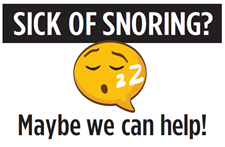Of course the main ones are known, such as high blood pressure – artery damage which includes hardening and gathering of cholesterol.
Some of the others might surprise you.
First a little exploring – as to why these issues are linked. Snoring – and many people attribute these problems to the more obvious form of ‘snoring’ which is Sleep Apnoea. Primary snoring still has real health problems.
One issue that repeatedly recurs, the twin issues of depression and anxiety. It may seem silly to point out that if your sleep quality is poor, you will wake fatigued and that compounds each day.
Sleep and breathing problems – often signaled by disrupted breathing – show up as Depression and its partner Anxiety. A frequently used medication to ‘help’ is a family of drugs – called SSRI or Serotonin Reuptake Inhibitors.
The name – very long is actually straight forwards. Serotonin – this is a chemical made inside your own body – and focusses on happiness – wellbeing – moods. Serotonin is designed to create of help these feelings to develop. Sadly in many people, their internally made Serotonin is sucked back up by their body – far too fast for the proper uses to have happened. So SSRI’s slow the body sucking this drug (Common Name = Citalopram Also Prozac Lexapro and Paxil – Zooloft A second – valid and useful medication – but as all do these have side effects.
If you are on be aware that an SSRI or an SNRI is recognised as an inducer (encourages it) to cause often severe tooth-grinding.
Recently an 80 year old man called in having split his top front tooth vertically.
While he is not taking these drugs, he still has fragmented sleep – yes snoring- and this is more than enough to upset the brain.
The solution is – as recommended by most viable health authorities indicate for mild-to-moderate sleep apnoea- the treatment of choice is an oral appliance.
Take a look at the options:–
Many anti-snoring devices are bulky – and as Professor Giles Lavigne (Quebec) shows their bulk takes up airway space and often nullifies their benefits.
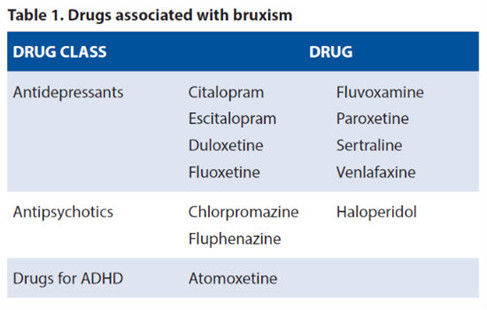
Migraine Tension headaches;
There are many such associations. Most of these neurological events are linked to the required shifting of the head to maintain a healthy airway.
When – as happens in arguably 2/3 of the population – there are growth impairments and the airway struggles to be big enough.
You can see this – and the associated size of the airway that is the part of the airway between the nose/mouth and the windpipe- is often narrowed.
This is almost certainly a product of increasing exposure of mothers (and of course baby) a few days after conception (week 2-3) The exposure is to tobacco – alcohol – sugar. This process wrecks the growth of the nose and the top jaw, in some cases there are no bones – cheeks, top jaw, sinuses.
For most these bones do grow – but controlled by different genetic programs and finish up smaller.
This does not encourage a good airway – and to get the best of what a child has – they adapt their posture.
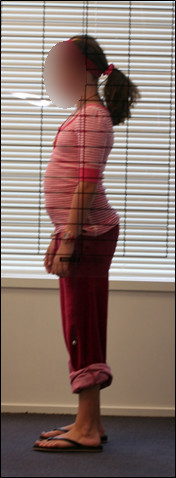
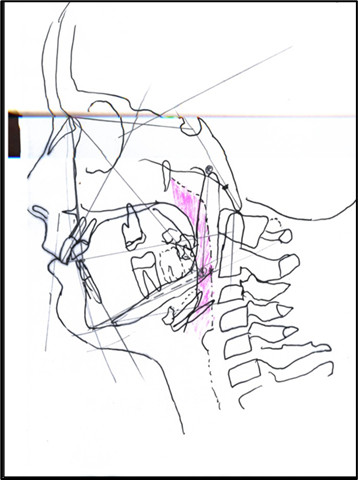
Here this fantastic young woman has changes in her whole posture. Head is forwards – shoulders hunched, the whole back is under strain and to help counter the weight of head-shoulders- arms – hands now in front of the ankle- vertical, there is a constant need to balance her weight. The brain has determined that the head MUST stay forwards to breathe. So what happens with the neck and head has to be countered with the legs and pelvis. Notice some of the ‘dorsal spines’ – these are the parts of the vertebrae that ‘poke out the back’. Numbers 2 & 3 as well as 3 & 4 are actually touching.
The very top vertebra is starting – see dotted line – to create a bone from the ligament- that is what started out as a ligament – is hardening up because of high loads.
Airway size. There are many ways to measure, but we use two in relation to the throat (pharynx) Radiographs – oral sonar which is pharyngometery ~ bouncing sound waves off the mouth and throat – measuring the echo both for ‘time’ that is how far down towards the windpipe and reply volume which is a measure of the reflective surface.
Ever wondered why so many have low-back problems?
Tension -Shoulders. The drive to breathe ensures the neck – spine and muscles all have to contribute to keep the airway open.
Here are some xrays of head & neck xrays – see how differently the upper spines adapt. None are normal and as such are prone to damage, that is arthritis and a few are at risk of serious damage. None of these are older than 16 years – how might they be in their 50’s?
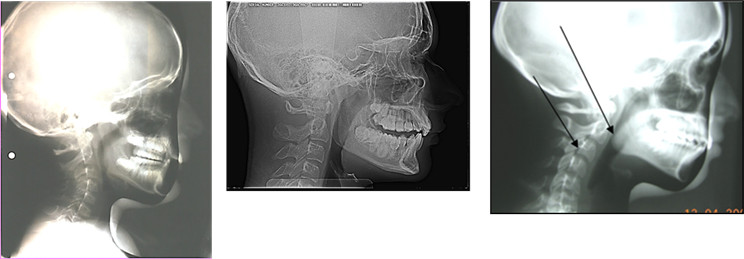
Image 2: The normal curve is lost – bones don’t slide over each other easily. This is a cause of lipping and arthritis.
Image 3: Here, a constricted upper airway was helped by bending the spine forwards, also abnormal. Here relationships are not smooth and the range of movement is limited.
Migraine:- It is widely researched and agreed that the jaw joint – where the tissues behind the ‘ball’ of the ball & socket, are loaded with the same nerves as you have on your eyeball, can be squashed – sending large numbers of pain signals into the central nervous system.
These signals are carried by a branch of the largest of all the 12 nerves called cranial nerves – that is those supposed to have their origin in the cranium (brain).
The front half of the brain is covered and protected by a complex layer of wrapping called the Dura Meninges and Pia Mater. These are innervated by the same nerve – as the jaw joint. Unsurprisingly when the jaw joint is winding up – so are all the branches of this very large nerve. Interestingly this nerve has siblings. One provides nerve to the chest and tummy – right down to the appendix. This is why when you have a migraine, nausea is often a factor.
By reducing the stimulation to this nervous system – even just placing something between your back teeth can often reduce, even stop the bulk of such stimulation – called nociception or noxious -stimulation [which means unpleasant – even harmful] While there are many means of subduing migraine – it makes more sense to remove the main source of creating it. That is reduce high levels of afferent nociception (Google this) “Physiopedia” ….
Nociception is a subcategory of somatosensation. Nociception is the neural processes of encoding and processing noxious stimuli.[1] Nociception refers to a signal arriving at the central nervous system as a result of the stimulation of specialised sensory receptors in the peripheral nervous system called nociceptors. Nociceptors are activated by potentially noxious stimuli, as such nociception is the physiological process by which body tissues are protected from damage. Nociception is important for the “fight or flight response” of the body and protects us from harm in our surrounding environment.
Tension Headaches
As you can see in the xrays and in the photos, it requires both bones of the skeleton and muscles that move these bones to move to abnormal positions, where what is a concentration of weight close to the vertical center-of-gravity – moving head-neck-shoulders-arms hands forwards changes balance. This is countered by flexing ( bending ) in the lower back – even gaining benefit from the ‘gluteal mass’ (that is your butt!) to balance against the head neck etc.
The tension in neck and shoulder muscles generates pain in these muscles and it also squashes the nerves underneath – against the bones. This generates ‘tension’ headaches. And again understanding that these headaches are less emotional and more mechanical can give insight and better clues as to resolving them.
In many cases an anti-snoring appliance will reduce the need to reposture the head and neck as the appliance will support the airway without so much postural change.
Cluster – and other headaches – these are more complex and have less relationship to airway and jaws. These are the province of your medical advisor.

